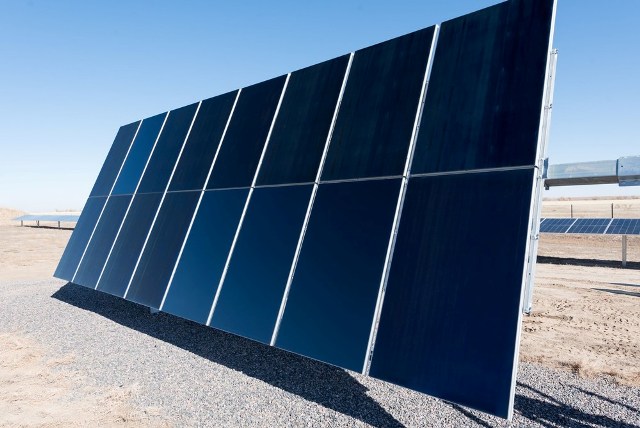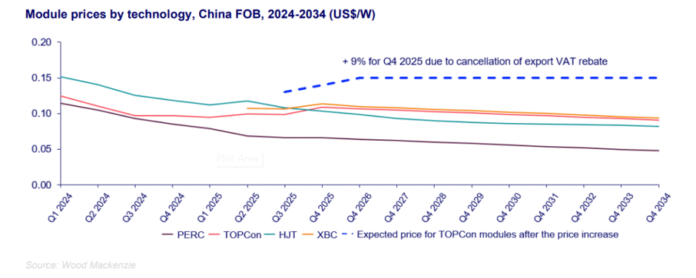Global solar and storage developers are bracing for higher procurement costs starting in Q4 2025, as new Chinese government policies and production cuts bring an end to the record-low pricing environment of the past 18 months, according to a report from Wood Mackenzie.
The report highlights that solar module prices are expected to increase by around 9 percent in Q4 2025, with further hikes projected through 2026. The surge will be driven by three factors: consolidation in the polysilicon sector, supply-side production cuts across the solar value chain, and the cancellation of China’s 13 percent VAT export rebate on modules and storage systems.
Why solar module prices are rising
For much of 2024 and early 2025, developers benefited from ultra-cheap solar modules priced at just US$0.07–0.09 per watt, as Chinese manufacturers sold at losses to clear excess inventory. However, this unsustainable trend has reached a turning point due to government intervention aimed at stabilizing the sector.
Polysilicon consolidation: Chinese polysilicon capacity expanded fourfold between 2022 and 2024, creating oversupply. New restrictions now cap expansion and mandate utilization cuts, forcing leading producers to scale down to 55–70 percent of capacity. This triggered a 48 percent jump in polysilicon prices in September 2025.
Supply-side cuts across the value chain: Module operating rates fell to 55–60 percent by mid-2025, with many legacy PERC production lines phased out, further reducing supply.
Cancellation of VAT export rebate: From Q4 2025, China will remove the 13 percent VAT rebate on exported modules and storage systems, significantly impacting global benchmark prices. Analysts expect the same for inverters, further raising costs for solar projects worldwide.
Impact on global solar and storage markets
With China accounting for more than 80 percent of global solar module supply and 90 percent of lithium iron phosphate (LFP) battery packs for storage, the ripple effect will be felt globally. U.S. developers, in particular, face higher storage project costs as they remain heavily reliant on Chinese equipment imports.
“Module manufacturers have already warned international customers to expect about a 9 percent price increase in Q4,” said Yana Hryshko, senior research analyst and head of Global Solar Supply Chain at Wood Mackenzie. “With no alternative supply in the short term, developers will have little choice but to absorb these higher costs.”
A structural market shift
Wood Mackenzie emphasizes that this represents a structural correction rather than a temporary spike. The new pricing environment is expected to stabilize margins for manufacturers, allowing them to reinvest in innovation, while forcing developers to adjust procurement strategies.
Even developers who locked in supply contracts earlier in 2025 may face renegotiations for deliveries scheduled after November, as the new pricing dynamics reshape the global solar and storage supply chain.

Leading solar module makers
China’s leading solar module suppliers are expanding aggressively, with massive investments in polysilicon, wafers, cells, and module production that underline their dominance of the global solar supply chain.
Tongwei has emerged as one of the most vertically integrated players, with polysilicon capacity of about 850,000 tonnes annually, alongside around 20 GW of ingots and wafers, 126 GW of cells, and 85 GW of module capacity. The company shipped roughly 45–47 GW of modules in 2024 and has begun production at a new 25 GW N-type cell plant, reinforcing its push into high-efficiency technologies.
JinkoSolar, ranked number one by Wood Mackenzie in 2025, has built a global manufacturing footprint spanning China, Malaysia, Vietnam, and the US, with around 90 GW of module capacity and 75 GW each of wafer and cell capacity.
JA Solar also remains one of the top suppliers, with global shipments among the highest in the industry and plans, along with peers, to exceed 100 GW of module capacity by 2027.
LONGi Green Energy continues to lead in wafers and high-efficiency mono modules, with expansions into back-contact and N-type cell technology, including a new 12.5 GW cell line in Xixian.
Astronergy, part of Chint New Energy, shipped nearly 19 GW of modules in the first half of 2024 and is scaling up advanced TOPCon product lines while expanding its overseas manufacturing footprint.
Across the industry, top Chinese manufacturers including Trina, Risen, and Canadian Solar are scaling aggressively, with the top 10 expected to surpass 100 GW of module production each by 2027.
China’s dominance is reinforced by its upstream strength, as the country expanded polysilicon capacity from 1.16 million tons in 2022 to over 2.1 million tons in 2023, accounting for more than 90 percent of global supply.
Baburajan Kizhakedath

